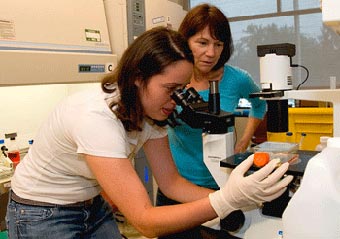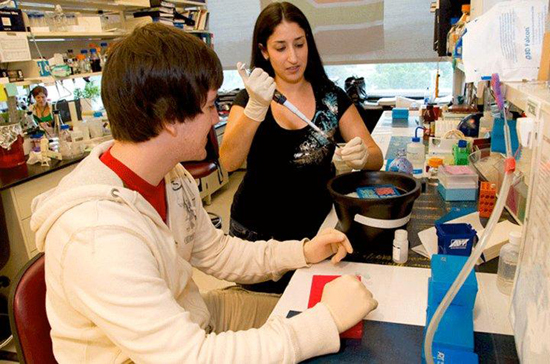UAlbany Researchers Tackle Rare, Deadly Form of Breast Cancer
Doctoral student Namita Chatterjee works with summer intern Tucker Conklin in the lab of Empire Innovations Professor Martin Tenniswood at UAlbany's Cancer Research Center. (Photo Mark Schmidt)
ALBANY, N.Y. (October 18, 2010) --
In the labs of UAlbany's Cancer Research Center, scientists and students are working, side-by-side, to investigate one of the most aggressive and lethal forms of breast cancer that most people don’t know exists.
Inflammatory Breast Cancer (IBC) comprises only 2 percent of breast cancer cases, but because diagnosis nearly always occurs after the cancer has already spread, IBC accounts for 8 percent of breast cancer-specific deaths, making it the most malignant form of breast cancer. IBC also disproportionally afflicts Hispanic and African American women.
Scientists examining "orphan" diseases, such as IBC, encounter challenges to securing funding for their research. A disease like inflammatory breast cancer impacts a relatively low percentage of people, providing little financial incentive for the private sector to make and market new medications to treat or prevent it.
"The median age at diagnosis is 51 years and the median overall survival is less than 4 years," said Empire Innovations Professor of Biomedical Sciences Martin Tenniswood, who also serves as director of the Cancer Research Center. "This means that women with IBC are diagnosed 10-15 years earlier than other forms of breast cancer, and die of the disease 15-20 years earlier."
One of Tenniswood’s graduate students, Namita Chatterjee, has been evaluating specific new treatments for this disease.
"My doctoral project is to develop cell culture model systems for evaluating new therapies for IBC," said Chatterjee.
 |
UAlbany summer intern Teresa Lloyd-Coronado looks through a microscope as Professor JoEllen Welsh looks on. (Photo Mark Schmidt) |
She has been helped by several talented students from institutions throughout the United States: Courtney Ensslin, a junior from the University of Notre Dame; Tucker Conklin, a sophomore from SUNY Geneseo; Matthew Mullins, a junior from the University of Maryland Baltimore County who participated in the UAlbany Collegiate Science and Technology Entry Program (CSTEP); and Brooke Pata, a junior in the Department of Biological Sciences at UAlbany.
Chatterjee's project is of particular significance due to the fact that there are only two cell lines derived from inflammatory breast cancer that can be used for the studies, compared to several hundred for other forms of breast cancer. Her work has shown that a new class of drugs -- called "histone deacetylase inhibitors" -- induce cell cycle arrest and cell death.
Chatterjee’s project depends greatly on the cutting-edge microarray facilities at the Cancer Research Center, headed by Dr. Sridar Chittur, which helps provide evidence that the drugs affect the messenger RNA and microRNA expression in the cells.
Chatterjee's work lays the foundation for new treatments for IBC using these drugs, either alone or in combination with current treatments. Tenniswood's team is now at work designing pre-clinical studies to ensure the drugs work in human subjects. This is especially important considering there are currently no targeted therapies for inflammatory breast cancer.
"Because the disease is already well advanced at diagnosis, the therapies designed for other forms of breast cancer (anti-estrogens, aromatase inhibitors, herceptin, and radiation) are not very effective for the treatment of IBC," said Tenniswood. "So it is essentially up to us to figure out why the current therapies don't work and to develop new leads."
The Cancer Research Center, a major component of the University's life sciences research endeavors, is located on the University at Albany's 87-acre East Campus, which is anchored by the School of Public Health and also serves as home to established and start-up biotech firms, as well as Tech Valley High School.
Private donations of more than $1 million are helping to bridge information gap between the CRC laboratories and the public. With the strength of more than 1,000 individual donors, the CRC has launched several innovative educational initiatives, including the inaugural Hogarty Family Foundation Lecture series, designed to educate the public on the latest developments in cancer prevention and treatment.
The school is commemorating 25 years of academic and research excellence in 2010-11 with a series of lectures, a film and fiction series, and other special events. With more than $30 million in new funding over the last 22 months, the School is conducting high-level research on some of the most profound health issues facing the world today. Through a unique partnership with the New York State Department of Health (NYSDOH), the School fosters growth and development on the East Campus through collaborative initiatives with established and start-up biotech firms, as well as Tech Valley High School and the Cancer Research Center.
![]() For more news, subscribe to UAlbany's RSS headline feeds
For more news, subscribe to UAlbany's RSS headline feeds
Educationally and culturally, the University at Albany-SUNY puts "The World Within Reach" for its 18,000 students. An internationally recognized research university with 58 undergraduate majors and 128 graduate degree programs, UAlbany is a leader among all New York State colleges and universities in such diverse fields as public policy, nanotechnology and criminal justice. With a curriculum enhanced by 300 study-abroad opportunities, UAlbany launches great careers. For more information about this globally ranked University, visit https://www.albany.edu/. For UAlbany's extensive roster of faculty experts, visit www.albany.edu/news/experts.shtml.





